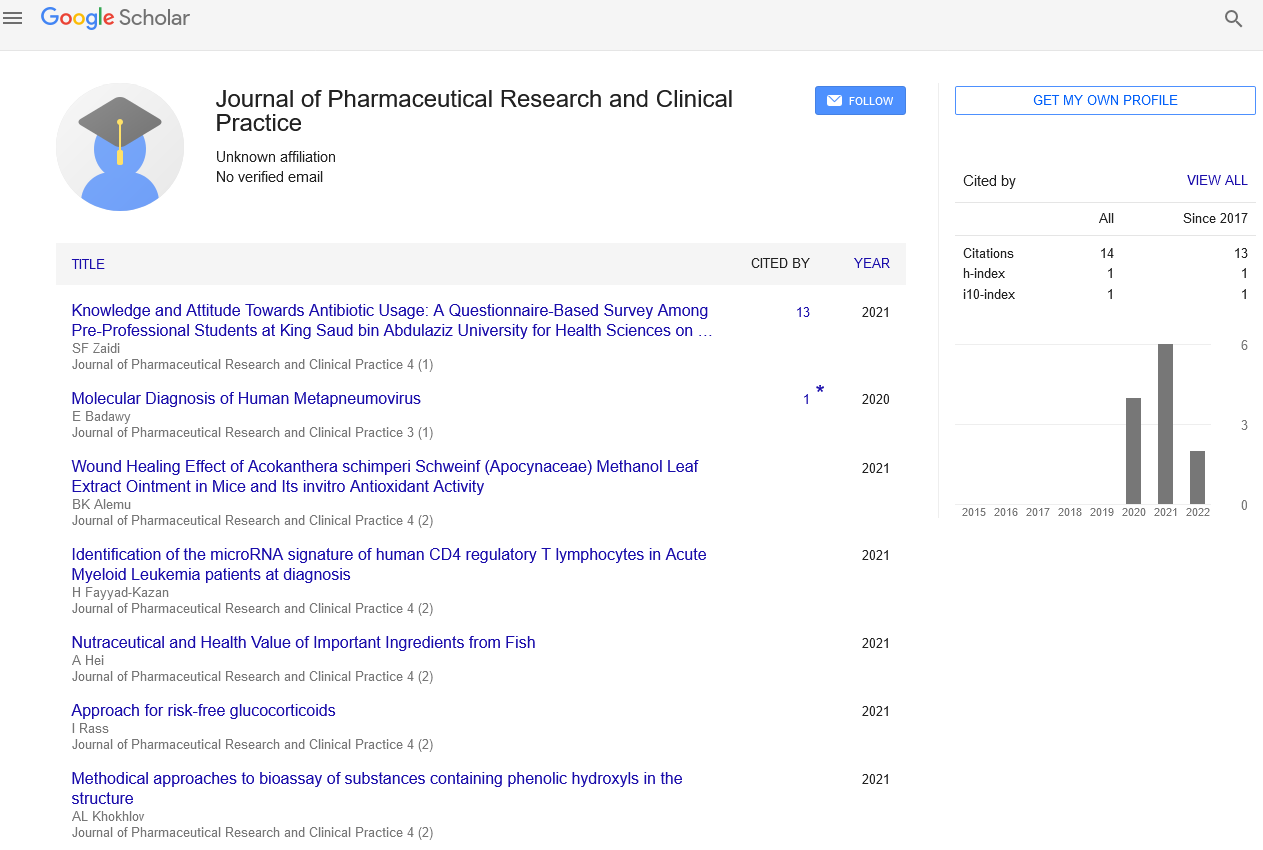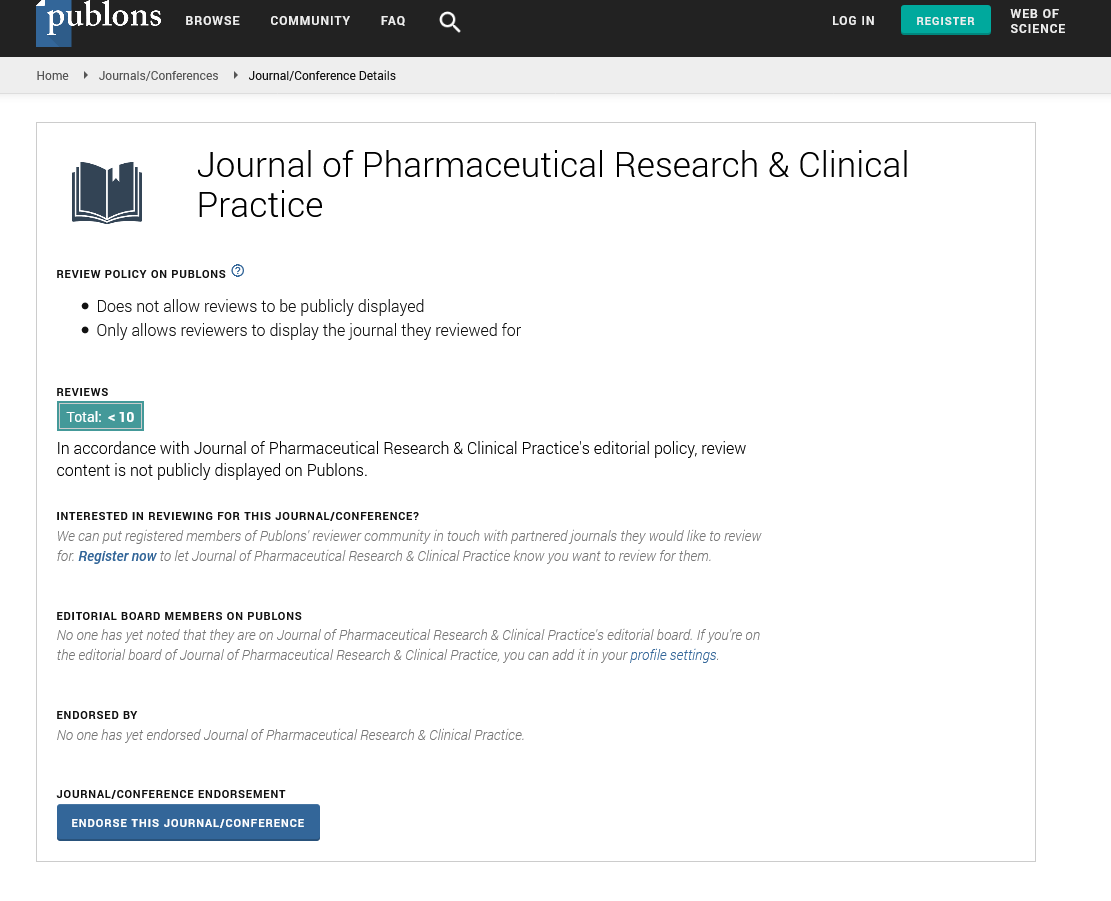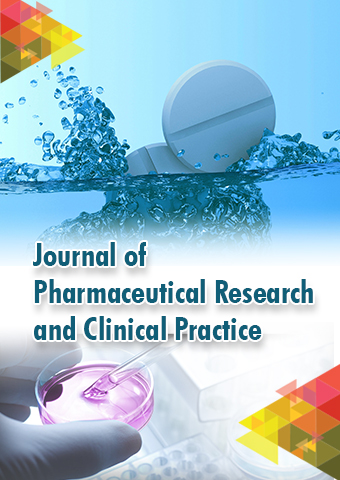Mini Review - Journal of Pharmaceutical Research and Clinical Practice (2023) Volume 6, Issue 2
A review on pharmaceutically relevant proteins
Ines Sebastian*
Department of pharmacy, University of Munich, Garching, Germany
Department of pharmacy, University of Munich, Garching, Germany
E-mail: sebasine@gmail.com
Received: 01-Apr-2023, Manuscript No. jprcp-23-95394; Editor assigned: 03- Apr-2023, PreQC No. jprcp-23-95394 (PQ); Reviewed: 17- Apr -2023, QC No. jprcp-23-95394; Revised: 24- Apr -2023, Manuscript No. jprcp-23-95394 (R); Published: 30- Apr -2023; DOI: 10.37532/ jprcp.2023.6(2).16-18
Abstract
The production of biopharmaceuticals is on the rise. Multiple diseases require them for treatment and prevention. In order to produce biopharmaceuticals more effectively, an urgent need has been identified for process intensification in downstream processing (DSP). The majority of the costs associated with producing pharmaceutically relevant proteins are currently covered by the DSP. This brief overview brings together important research from the past three years that looks at novel ways to get around this bottleneck. The overview includes promising research on the purification of pharmaceutically relevant proteins using chromatography, aqueous two-phase systems, precipitation, crystallization, magnetic separation, and filtration.
Introduction
The industry is facing the challenge of manufacturing large quantities of therapeutic proteins, such as monoclonal antibodies (mAbs), in an effective manner due to the rapidly rising market demand. The current production process bottleneck shifts to the purification of protein products in the subsequent downstream processing (DSP) after recent process-intensification improvements in the upstream processing (USP). The capture, purification, and polishing steps of DSP of therapeutic proteins are typically carried out using chromatography and filtration techniques. Clarification by filtration and/or centrifugation follows. DSP’s objective is to increase the concentration and purity of the target molecules.
The pricey chromatography steps account for a significant portion of the DSP’s total production cost for biopharmaceuticals. Stuffed bed chromatography has been the modern workhorse for a really long time as it accomplishes incredible yields and purities. However, processing the increasing volumes and titers of USP may require conventional chromatography to its limits [1- 3]. As a result, research into novel and alternative technologies that enable process intensification is on the rise. The use of single-used equipment, the improvement of process control, and the use of scale-down models for more efficient process development are some of the current strategies for process intensification. Innovative DSP strategies are outlined in detail. The majority of downstream processes will always require multiple steps and purification cascades; however, we would like to draw attention to the most recent trends for novel processing concepts and separation procedures.
Precipitation is a promising alternative technique because of its rapid and robust processing of high titers and large volumes, scalability, high yields, and low costs [4]. Precipitation has recently been shown to be a useful alternative to the limited protein-A chromatography that is currently used for mAb capture. To meet the requirement for process intensification, tubular reactor designs can be used to implement continuous processes. In addition, the current mAb-purification platform procedure can include precipitation and subsequent washing (and resolubilization) steps. Nonetheless, precipitation can impact other cleansing advances altogether. Recently, it was shown that ZnCl2 and polyethylene glycol (PEG) can effectively precipitate mAbs. Dutra and co. developed a PEG-free ZnCl2-based precipitation method that improves precipitate harvesting and washing by making the processed fluid less viscous.
For the purpose of selectively capturing and purifying mAbs and other therapeutic proteins, affinity precipitation with, for instance, stimulus-responsive elastin-like polymers or Ca2+- dependent calsequestrin fused to affinity peptides has recently been utilized with great success. Partiality precipitation is promising as improved peptides permit the development of a hearty stage viable cycle, for instance, like protein-A fondness chromatography utilized in ebb and flow mAb-sanitization stage processes [5-7]. The FDA’s “Quality by Design” (QbD) concept could be approximated by current process analytical technology (PAT) research, which could accelerate precipitation-process development and guarantee product quality in the future.
Amorphous precipitates lack the purity and physicochemical stability of protein crystals, which have ordered protein configurations. In this manner, crystallization can be utilized in middle and cleaning steps in DSP. Another benefit is the conceivable ideal controlled arrival of restorative proteins from the gem grid when utilized as medication detailing. Similar to antibody crystallization; protein crystallization is a thermal process that is dependent on the protein’s supersaturation. Similar to the crystallization of small molecules, protein crystallization necessitates slow changes in pH, ionic strength, and/or temperature, as well as mild conditions modifications like salts or polymers (cooling crystallization). However, the difficulty of implementing the crystallization process is a major obstacle. A straightforward crystallization process is hampered by the large size and intricate structure of proteins, particularly mAbs with their flexible hinge region [8]. As a result, the current research focuses on gaining a deeper comprehension of crystal growth and nucleation by employing mathematical methods 19, 20 and empirical high-throughput screening.
In the literature, the main reasons why ATPS is not yet established in DSP are discussed. There are no large-scale studies or promising continuous application process designs for ATPS, and the underlying mechanisms of ATPS’s effect on biomolecule partition are still poorly understood. However, these knowledge gaps are the goal of researchers. The expectation of parcel coefficients is presently researched. The use of coiled flow inverters for extraction processes, among other reactor systems, is tested. The development of (continuous) microfluidic screening provides support for understanding and mathematical modeling. New phase-forming components, like ionic liquids, as well as ways to improve the process strategy (like multistage extraction or phase/component recycling, for instance) are currently the subject of research. In addition, reactive ATPS and magnetic-assisted ATPS offer additional methods for intensifying the process [9]. Three-phase partitioning processes, in addition to ATPS, demonstrate advantages for protein purification procedures. For future process development and scale-up, a systematic understanding of ATPS based on small-scale screening is considered crucial.
A classic separation mechanism that is frequently utilized in chromatographic procedures as well is the binding of a pharmaceutically relevant protein to a solid phase, such as a mAb. In addition, DSP and antibody purification can benefit from a variety of batch-adsorbent materials and adsorption procedures. In contrast to packedbed systems, batch-adsorption systems based on magnetic separation are the primary focus of this section. Utilizing ferromagnetic, ferrimagnetic, or superparamagnetic carriers that carry a specific binding site, such as protein-A or protein-G domains, is a current trend in these adsorption processes. The straightforward separation of the bound phase from the nonbound phase is a benefit of magnetic-based processes. As a result, protein-capture steps are well suited for this mechanism [10]. In addition, high-gradient magnetic separation processes and separator and process design as well as process integration is continually improved. Demonstrated that antibody capture with magnetic beads can be carried out effectively at extremely high cell densities. Attractive partition cycles could give a maintainable option in contrast to protein-A chromatography for future DSP because of the energy-proficient division that can be utilized in beginning phases of the DSP without past collect filtration and centrifugation steps that are essential for stuffed bed frameworks.
Discussion
Higher flow rates, which boost productivity, are the main advantage of membrane chromatography over conventional chromatography. Practical production of layer adsorbents offers the chance of single-use, lessening tedious and expensive cleaning and approval techniques of stuffed bed segments in biopharmaceutical applications. Increasing membranes’ binding capacities, which have long been a major drawback, is the focus of a lot of research. The utilization of nonwovens and electrospun nanofibers showed outcome in decontaminating remedial antibodies and different proteins. Roshankhah and others developed a cation-exchange z2 laterally fed membrane chromatography (z2LFMC) process for antibody purification that was three times more productive than conventional protein-A chromatography. Numerous recent studies also focus on understanding the binding and elution mechanisms of mAbs. Despite the numerous novel approaches in DSP, chromatography remains the working horse for the purification of pharmaceutically relevant proteins.
Conclusion
The surveyed examinations recommend energizing improvements in biopharmaceutical DSP before long. We are confident that some of the aforementioned methods will be put into use, resulting in improved and longer-lasting protein production for use in pharmaceuticals. However, it will be difficult in the future to persuade regulatory authorities of new purification methods as an alternative to established chromatography techniques.
Conflict of interest
The authors declared that there is no conflict of intrest.
Acknowledgment
None
References
- Das J, Ghosh J, Manna Pet al.Taurine protects rat testes against doxorubicin-induced oxidativestressas well as p53, Fas and caspase 12-mediated apoptosis.Amino Acids. 42, 1839–1855(2012).
- Holley AK, Dhar SK, Xu Yet al.Manganese superoxide dismutase: Beyond life and death.Amino Acids. 42, 139–158(2012).
- Hossain S, Yamamoto H, Chowdhury EHet al.Fabrication and intracellular delivery of doxorubicin/carbonate apatite nanocomposites: Effect on growth retardation of established colon tumor.PLoS One. 8, 1–11(2013).
- Farolfi A, Melegari E, Aquilina Met al.Trastuzumab-induced cardiotoxicity in earlybreast cancerpatients: A retrospective study of possible risk and protective factors.Heart. 99, 634–639(2013).
- Li MQ, Song WT, Tanget al.Nanoscaled poly (L-glutamic acid)/doxorubicin-amphiphile complex as pH-responsive drug delivery system for effective treatment of nonsmall celllungcancer.ACS Appl Mater Interfaces. 5, 1781–1792 (2013).
- Abbas-Terki T, Blanco-Bose W, Deglon Net al.Lentiviral mediated RNA interference.HumGeneTher. 13, 2197–2201 (2002).
- Abdelgany A, Wood M, Beeson D.Allelespecific silencing of a pathogenic mutant acetylcholine receptor subunit by RNA interference.Hum Mol Genet. 12, 2637–2644 (2003).
- Agrawal N, Dasaradhi PVN, Mohmmed Aet al.RNA interference: biology, mechanism, and applications.Microbiol Mol Biol Rev. 67, 657–685 (2003).
- Ashrafi K, Chang FY, Watts JLet al.Genome wide RNAi analysis of Caenorhabditis elegans fat regulatory genes.Nature. 421, 268–272 (2003).
- Berns K, Hijmans EM, Mullenders J.A largen scale RNAi screen in humancellsidentifies new components of the p53 pathway.Nature.428, 431–437 (2004).
Indexed at,Google Scholar ,Crossref
Indexed at,Google Scholar ,Crossref
Indexed at,Google Scholar ,Crossref
Indexed at,Google Scholar ,Crossref
Indexed at,Google Scholar ,Crossref
Indexed at,Google Scholar ,Crossref
Indexed at,Google Scholar ,Crossref
Indexed at,Google Scholar ,Crossref
Indexed at,Google Scholar ,Crossref


